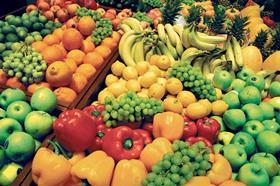
Times are changing in the produce category as during the last year growth has been driven by frequency, rather than price, for the first time in years.
Whether this signals the beginning of the end, or at least a new era, in the omnipresent price war, or the successful trend for healthier eating, is hard to say. But sales are undoubtedly up – 2.3 per cent in value and 3.3 per cent in volume over the last 12 months according to Kantar – and despite the uncertainty of Brexit, there is much to be positive about in the produce business.
Kantar analyst Lauren Webb explains: “Growth has been driven by shoppers buying fresh produce more often, with the average household now making 103 wholehead produce trips per year, up three per cent on the year before. The growth in the latest year driven by frequency is a move away from the previous few years where the wholehead produce market’s performance was driven by price per kg.”
Fruit is doing particularly well, now taking more shopper spend than veg and accounting for 51.5 per cent of the wholehead produce market, although veg still holds a larger share in terms of volume. Within the category, shoppers’ tastes are diversifying as they choose more exotic options, with ginger, lime, sweet potatoes and persimmon all experiencing triple-digit growth over the past five years, according to Webb.
Wholesaler Mark Tate, of Birmingham firm George Perry, echoes this changing consumer palate, noting that avocados, kiwi, kale, blueberries and mango have all made the move from exotic to mainstream, and are “substantially” more popular than they were five years ago. Meanwhile, the profile of roasted veg dishes on TV chef programmes has boosted veg sales, says Tate, as well as seasoning staples such as garlic and ginger as home cooking becomes more popular.
Of course, price is still the big driver behind shopper decisions. “The consumer is still driven by special offers and anything we can put on at two or three for £1 are still the biggest drivers to get customers across the threshold,” says Tate, who also runs Midlands grocery retail chain Joe Richards.
Brexit looms large across many produce industry discussions, with seasonal labour, trade agreements and plant protection top of the list of concerns. Lee Abbey, NFU horticulture adviser, notes that it’s been said that the vote for Brexit was a vote for Britishness, and there are opportunities to capitalise on this in produce. “First of all, consumers place a lot of confidence in homegrown food and retailers are increasingly looking for the opportunity to put the Union Jack on fresh produce packs,” he says.
“Relatively little UK fruit and veg is exported, so the biggest opportunities are for import substitution. Having said that, the UK climate is changing and we are seeing fruits and vegetables grown in this country, which we’re used to getting from other parts of the world. New technologies, such as LED lighting in glasshouses, also provide opportunities for us to become ever more competitive.”
Initiatives such as the NFU’s Fruit and Veg Pledge, which encourages retailers to source more British produce, as well as the body’s Fit for the Future healthy eating programme, are additional frameworks designed to grow the future of the industry, adds Abbey.
There is much work to be done to ensure that produce receives the support it needs to succeed post-Brexit. But innovation in the produce aisle and a rapid response to the desire for convenience could help maintain consumer interest during the uncertainty of the next few years.



